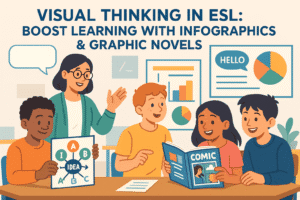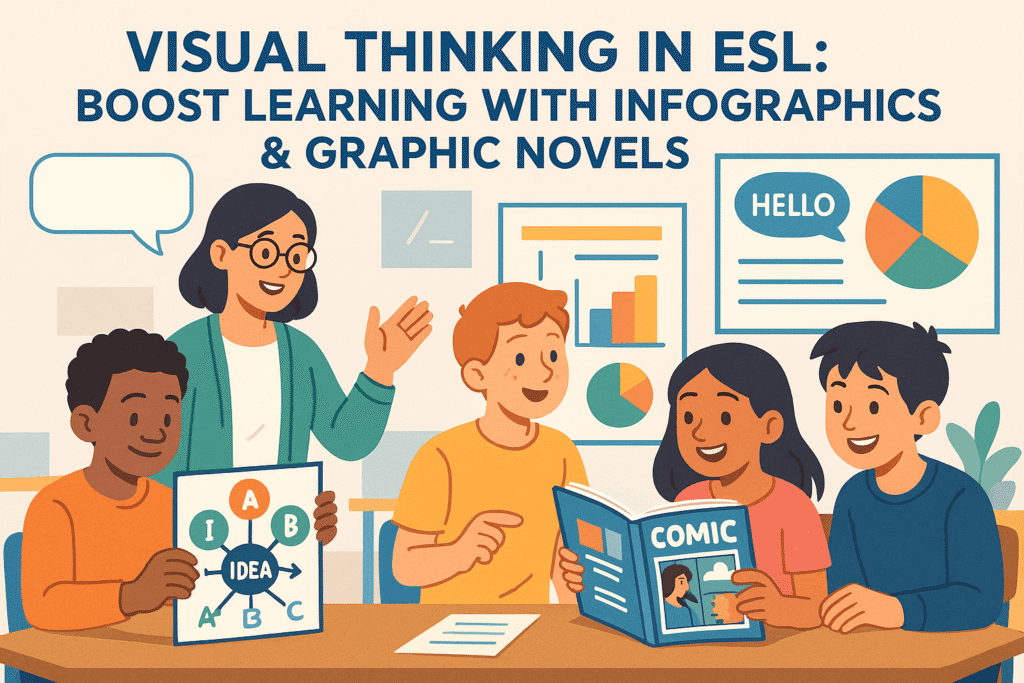In today’s ESL classrooms, teachers are always looking for ways to help students learn English more effectively. One powerful method that is becoming more popular is visual thinking in ESL. Visual thinking uses pictures, symbols, and drawings to help students understand and remember English words and ideas. This blog explores how ESL teachers can use infographics, graphic novels, and sketchnotes to support students in learning English in fun and creative ways.
What is Visual Thinking in ESL
Visual thinking means using images to think, understand, and learn. It helps people to make connections between ideas and to remember new information better. For ESL learners, especially beginners, visual support can make a big difference. It makes English more understandable, especially when words are new or hard to explain.
Incorporating Visual Thinking in ESL can enhance the learning experience further by providing visual context and engagement.
When you use visual thinking in class, students can:
- Understand complex ideas more easily
- Remember vocabulary for longer
- Learn grammar through examples they can see
- Feel more confident using English
Let’s look at three great tools you can use: infographics, graphic novels, and sketchnotes.
Using Infographics in ESL Teaching
What are Infographics
Infographics are visual presentations of information. They mix pictures, charts, and simple text to explain something clearly. They are great for showing data, steps, comparisons, and other concepts.
Why Use Infographics in ESL
Infographics help ESL students by:
- Showing information clearly and simply
- Supporting vocabulary with images
- Helping visual learners understand better
- Making content more interesting and fun
How to Use Infographics in the Classroom
- Vocabulary Lessons: Use infographics to show word families, food groups, weather types, or travel vocabulary.
- Grammar Topics: Create simple grammar charts like verb tenses, prepositions, or sentence structures.
- Reading Comprehension: Give students a simple infographic and ask them to answer questions based on it.
- Speaking Practice: Ask students to describe an infographic in their own words.
You can create your own with tools like Canva or Piktochart.

Graphic Novels A Fun Way to Build Language Skills
What are Graphic Novels?
Graphic novels are stories told with both pictures and words. They are longer than comic strips and have full plots and characters.
Why Graphic Novels Help ESL Students
Graphic novels are very helpful for English learners because:
- Pictures support understanding of the story
- Dialogue shows how real people speak
- Stories are interesting and motivating
- They include everyday language and slang
How to Use Graphic Novels in ESL Class
- Reading Practice: Use beginner-friendly graphic novels to help students read with confidence.
- Speaking Activities: Ask students to act out scenes or describe what is happening.
- Vocabulary Building: Highlight key words or expressions from the story.
- Writing Exercises: Ask students to create their own comic page or write an ending to the story.
Recommended resource: TOON Books offers easy-to-read graphic novels for young readers.
Tips for Getting Started with Visual Thinking
If you want to try visual thinking in your ESL classroom, start small:
- Begin with simple visuals: stick figures, arrows, and symbols
- Encourage all students, even those who say they can’t draw
- Use templates or guides to help with layout
- Combine visuals with speaking or writing tasks
- Let students work in pairs or groups to build confidence
Real Classroom Examples
Here are a few ways ESL teachers are already using visual thinking:
- A teacher in South Korea uses infographics to teach travel vocabulary before students plan a pretend trip.
- A teacher in Vietnam uses graphic novels like “The Arrival” to discuss immigration and family.
- In Thailand, students create sketchnotes after watching short English videos.
These ideas not only help students learn English, but also let them express themselves in new and exciting ways.
Where to Find Resources
You can find many free or low-cost visual learning tools online:
- Canva: Free templates for making infographics
- Piktochart: Easy visual design for teachers
- TOON Books: Great graphic novels for young learners
- Ellii: Printable ESL resources with visuals
These platforms offer excellent support for teachers who want to try something new and engaging in their classrooms.
Final Thoughts
Visual thinking is a powerful and creative way to teach English. Tools like infographics, graphic novels, and sketchnotes can make lessons more interesting, fun, and effective. They help ESL learners understand better, remember more, and feel more confident using English.
By using pictures, stories, and creative drawings, we can make English come alive for our students. Try adding one new visual activity to your next lesson, and see how your students respond. You might be surprised by how much they enjoy it!


